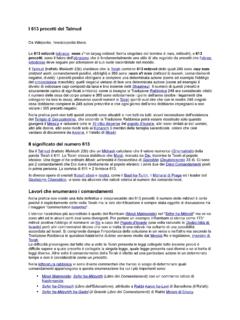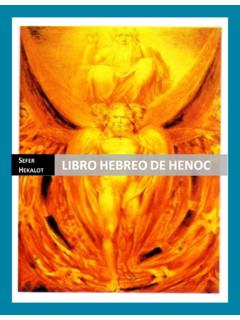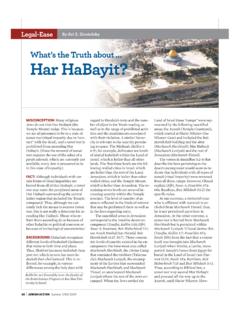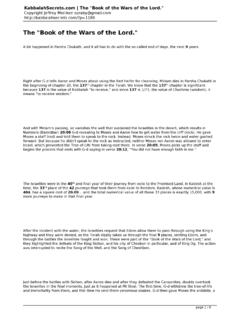Transcription of D'oraita, D'rabanan and Divrei Soferim: Interpretations to ...
1 Rabbi Moshe Becker 159 D'oraita, D'rabanan and Divrei soferim : Interpretations to shoresh Sheini of Sefer Hamitzvot Rabbi Moshe Becker Preface Rambam215, in the introduction to his Sefer HaMitzvot, presents the rules and principles that form the guidelines for determining which Mitzvot are to be included in the count of the Mitzvot216. Rambam maintained that the Monei HaMitzvot 217 who preceded him were often mistaken, basing their count on faulty methodology. To rectify the situation, Rambam prefaced his count with a detailed explanation 215 pain, Egypt, 1135/8-1204 216 The concept of the count of Mitzvot originates in the statement of R' Samlai (Makkos 23b) that 613 Mitzvot were given to Moshe on Sinai.
2 217 The authors of works listing the Mitzvot. For the most part Baal Halakhot Gedolot ( " ). Others are R' Saadya Gaon, R' Shlomo Ibn Gabirol D'oraita, D'rabanan and Divrei soferim : Interpretations to shoresh Sheini of Sefer Hamitzvot 160 of his own methodology, in which context he points out the mistakes of his predecessors. However, many of his statements proved to be quite controversial, both in substance as well as his rejection of the earlier, accepted methods. In this study we will focus on the principle stated by Rambam in shoresh Sheini and the various approaches to understanding it that developed over the generations following Rambam s statement in shoresh Sheini We have already explained in our Introduction to the Mishna that most laws of the Torah are learned by way of the 13 exegetical principles.
3 Thus not every law that we find the Sages learning by way of the 13 exegetical principles will we assume that it was said to Moshe on Sinai, but we will also not say that such a derivation is necessarily of Rabbinic authority, as it may have been a tradition (from Sinai). Therefore, anything that is not found to be written in the Torah, but is found in the Talmud as having been learned through one of the 13 exegetical principles219 if they themselves (the Sages of the Talmud) clarify and say that it is d'oraita or guf torah it can be counted as a Mitzvah because the bearers of the tradition said it is d'oraita. If no such statement is made, it is D'rabanan as there is nothing written (in the Torah) to indicate it.
4 218 The most comprehensive discussion of this topic to date is Yehuda Neubauer's HaRambam Al Divrei soferim [Jerusalem: Mossad Harav Kook, 1957], which covers nearly all the available material on the topic. Our goal is to present the major opinions and trends in the analysis of shoresh Sheini. 219 Rambam is not limiting this to the 13 principles the same will be true for any of the hermeneutic tools known as drashot. Rabbi Moshe Becker 161 Rambam: Sefer HaMitzvot shoresh Sheini Following the above, Rambam goes on to show how others made the mistake of including in the Mitzvot those which he just excluded, and attacks them for being inconsistent.
5 At face value, he seems to be saying something very clear: The only Mitzvot that can be considered d'oraita are either those that can be found explicitly written in the Torah, or those that are presented in the Talmud as having been learned through one of the 13 principles, but the Talmud says is actually d'oraita. Otherwise, anything learned by way of the 13 principles is to be called D'rabanan . This statement, simple as it may be, should be quite shocking to anyone familiar with the Talmud. The general understanding is that the 13 exegetical principles were tools given to Moshe together with the Torah as a means of getting to the true meaning and intent of the passuk220.
6 Consequently, anything derived from the passuk by using those methods carries the same authority as that which is written explicitly, and is to be considered d'oraita. An illustration of the apparent difference between the approach of Rambam and the generally understood principles of the Talmud is the oft-used statement in the Talmud It is really Rabbinical, and the passuk is just support, a solution often applied when the Talmud finds a passuk seeming to dictate a Halakha that is understood to be of Rabbinic authority. The implication is that unless the Talmud specifically says otherwise, wherever we find a Halakha derived from a passuk, namely something learned from the 13 principles, we assume that it is d'oraita.
7 According to the rule set out by Rambam, the opposite should be true; by default, all Halakhot derived through the 13 principles will be D'rabanan , unless there is special indication to the contrary. 220 Referring here to any verse in Scripture. D'oraita, D'rabanan and Divrei soferim : Interpretations to shoresh Sheini of Sefer Hamitzvot 162 Although some of the categories put forth by Rambam elsewhere may only hold value to classify various types of Halakhot or Mizvot221, here the terminology is crucial because it has major legal repercussions. Probably the most significant one is the case of a safeik - a situation in which the proper ruling cannot be determined.
8 Throughout Halakha, in any situation of doubt we follow the following rule: If the uncertainty involves a Halakha of d'oraita status, we must be as stringent as necessary to avoid violating a Biblical directive. If however we are facing a Rabbinic issue, we take a more lenient position222. As Rambam points out223, were those who counted the Mitzvot derived from the 13 principles correct, there would be many thousands of Mitzvot. Accordingly, there would be many, many scenarios where in a situation of doubt Rambam would rule to be lenient, while the earlier authorities would maintain that given the d'oraita authority of the Halakha, one must be stringent.
9 Clearly we are not dealing with a minor semantic disagreement, but rather an argument with colossal legal implications. However, it seems that the legal implications, although serious enough to elicit an outcry, are not the only issue that Rambam s new principle raises. With the principle given here, Rambam has effectively moved the majority of Halakha from being of Siniatic (and thereby Divine) origin to the realm of the Rabbinic, in origin as well as authority. Such a position leaves room for the claim that Judaism is 221 For example, although Rambam in the introduction to Peirush HaMishnayot divides the Mitzvot into five categories, in that context he does not deal with the authority or stringency of any given category per se.
10 However as we will see and as Rambam himself began, there is certainly a connection between the category created here and those given in Peirush HaMishnayot. 222 Although this is a general guideline in Halakha, it and Rambam's particular position in the matter are a topic of discussion on their own which will not be dealt with here beyond it's immediate relevance. 223 Later on in shoresh Sheini, as an additional objection to Halakhot Gedolot Rabbi Moshe Becker 163 indeed a man-made religion, a claim which the medieval authorities expended much energy to disprove. This combination of legal ramifications and theological difficulties prompted harsh attacks by Rambam's contemporaries and, in later generations, attempts to redefine or limit parameters of the principle given in shoresh Sheini.








